
Often overlooked, a website’s Frequently Asked Questions (FAQs) section can be surprisingly important, particularly in the education sector. For prospective students, an FAQs page can be the first port of call to try and find out anything they cannot easily see or find elsewhere on your site, and gain answers to their most pressing questions and queries.
What’s more, the rise of voice search and other recent developments have conspired to make query-based searches increasingly popular, meaning your FAQs could now play a crucial role in your SEO strategy.
Despite this, these pages are often neglected by schools, with little thought put in to creating and updating them. Here’s what you should be asking yourself about your FAQs page.
Do Your FAQs Speak to Your Student Personas?
The purpose of FAQs should be self-explanatory: to answers the most common queries your audience has. Too often, however, schools and other organizations can lose sight of this, resulting in pages which simply group miscellaneous information together, are too promotional, or even avoid dealing with tough or problematic questions.
To remedy this, a school should consider their audience and ask themselves what they are most likely to want from this page. A good place to start is your student personas. When executed well, they should provide you with a comprehensive summary of your main audience’s shared concerns and the questions they are likely to have during the enrollment process.
Example: This is a persona developed for a private career college in Canada.

Based on the motivations and concerns highlighted alone, you can already see a number of questions that may need to be included in the school’s FAQs, such as:
- What is a typical class schedule like?
- Is financial aid available to students?
- What is the difference between a qualification offered at a private career college and one offered by a public community college?
Addressing these queries in your FAQs can instantly allay some of the main concerns prospective students will have about your institution, and increase their chances of progressing down the admissions funnel.
Your school can also identify additional FAQs through their communications with prospective students. If you find that several leads ask the same question when contacted, it is probably a good indication that the answer should be in your FAQs. You can make these questions easier to identify by using a CRM system to log calls, texts, and emails you receive, allowing you to keep a record of what comes up the most.
Another important point is that your FAQs section shouldn’t just be a place for questions that aren’t answered elsewhere on your site. You should think of your FAQs as a one-stop shop for all the most pertinent questions about your school, and include anything you think prospects are likely to ask, even if you feel information about it is featured prominently on other pages.
For instance, most schools will have dedicated pages regarding financing, but it is still likely that some prospects will happen upon your FAQs first. Having some content that answers questions about this in your FAQs will ensure that all your bases are covered. You can also link to other pages in the site that offer more depth about specific things to encourage prospective students to find out more.
Is Your Education Website FAQs Section Easy to Read?
More than many other pages on your education website, an FAQs section can quickly become long and unwieldy. Your school may have a lot of information it needs to cover relating to several different areas. It will also likely need to consider a variety of audiences apart from just its prospective students, including current students, alumni, parents, staff, and members of the local community.
With that in mind, it is worth putting some thought into how best to arrange and present this section. There are a number of possible options to do this, and much will depend on the amount of content you have. Schools with only a handful of questions to answer will usually find that a simple one page section presented in a Q&A format will suffice.
Example: English Studies Institute, an ESL school in California, keeps its FAQs page simple and to the point.
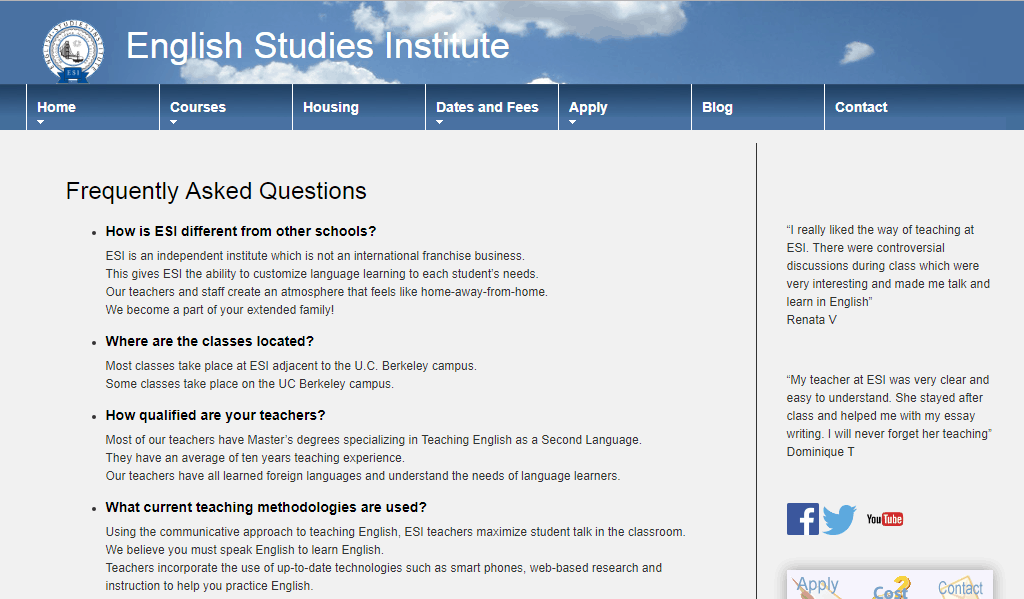
However, if it needs to be longer, you may have to rethink the architecture of the page. Many schools will divide the questions into sections, with each covering a specific area, so that visitors can easily find answers by looking in the section of the page their question pertains to.
Example: Victoria School of English divides its FAQs page into sections to make it easier for prospective students to find what they are looking for.
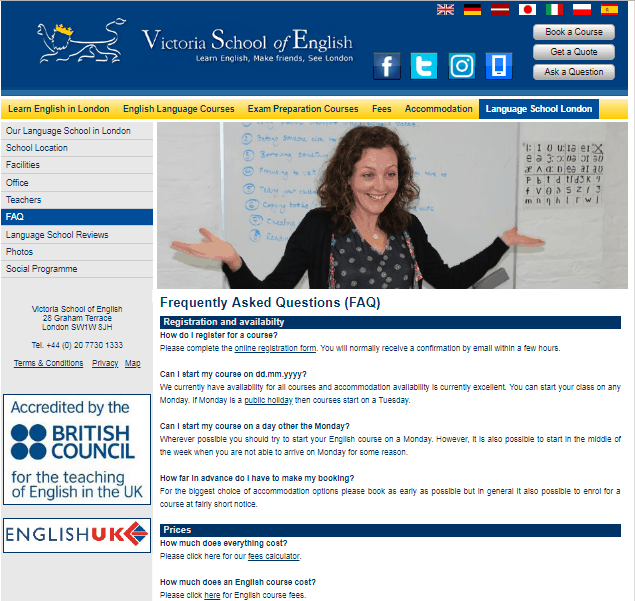
Another option is to present all of the questions in question form only at the top of the page, with each hyperlinked in order to direct the user towards the answer. This allows users to find the question they are looking for without having to scroll. Other schools will take this further by giving each answer its own web page, and directing users to it through hyperlinks. This approach has the advantage of creating individual pages for SEO indexing.
Example: The University of Guelph’s FAQs page includes a link to an individual page for each answer.
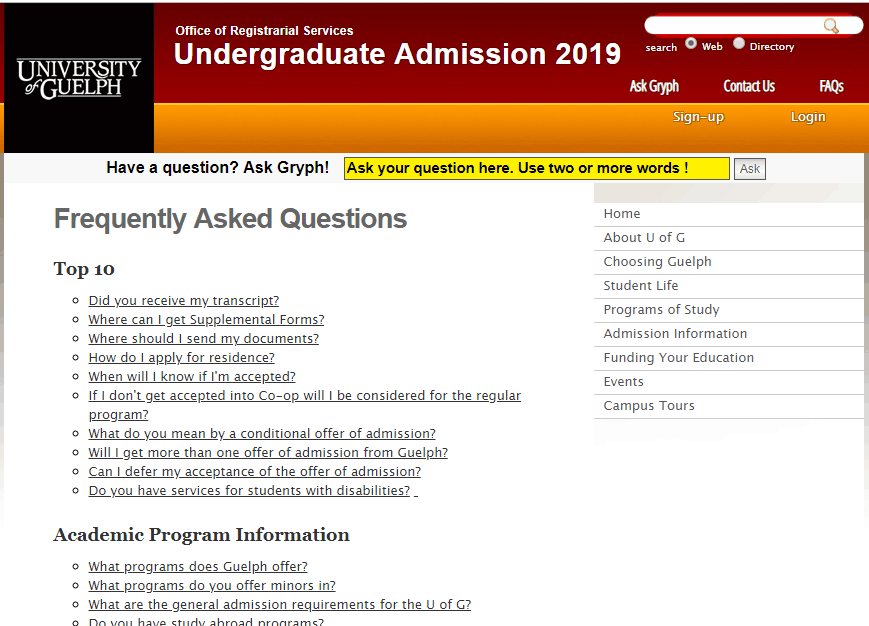
Lastly, an increasingly popular approach for modern FAQs pages is to use an ‘accordion’ menu. This involves presenting a set of clickable questions which expand on the same page to reveal their answers. Each of these questions can also be assigned a unique URL for SEO indexing purposes. This approach allows users to find all their answers on a single page, while still keeping it concise and easily navigable.
Example: The University of Glasgow uses an accordion menu for its FAQs page. Note how each section has its own unique URL.
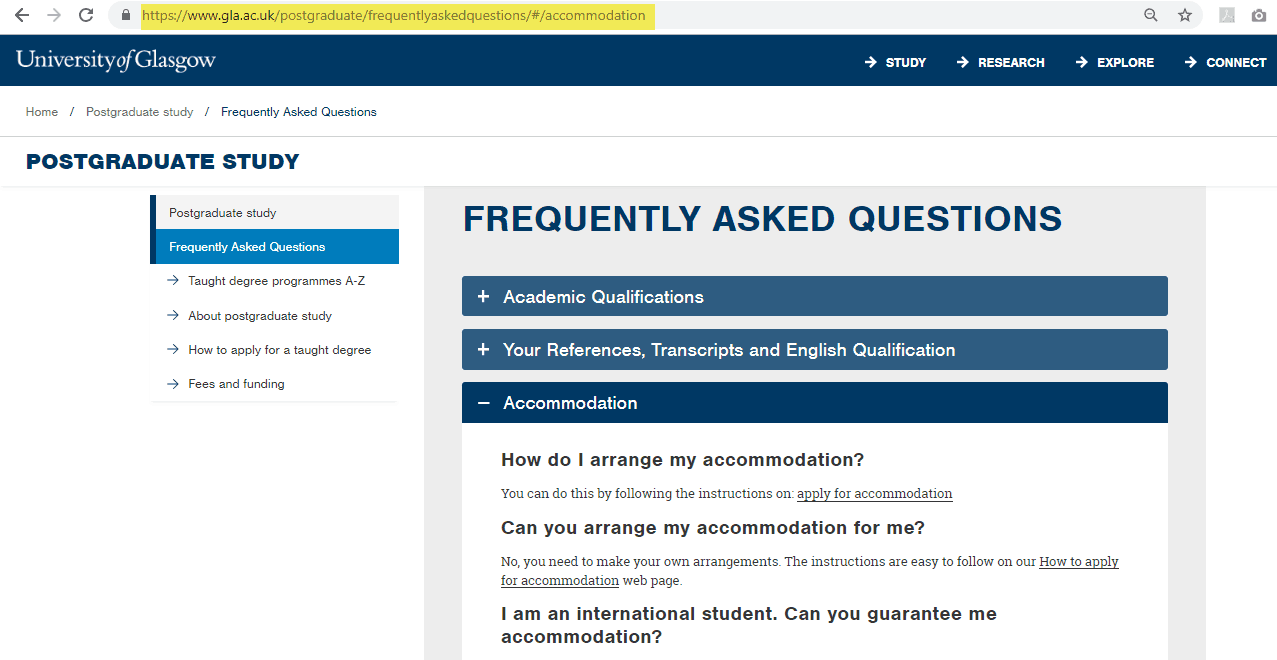
All of these options can have merit and it will be up to your school to find the right one for your needs. Adopting a content first approach is advisable, and will allow you to opt for a design that adheres to education website best practices while still easily fitting the information you need.
Are Your School’s FAQs Optimized to Maximize SEO Value?
As mentioned earlier in this blog, FAQs have become a valuable tool for SEO in recent years. The main reason for this has been the introduction and evolution of virtual voice assistants like Siri, Alexa and OK Google. Combined with increasing investment in machine learning which better recognized user intent, this has resulted with an almost imperceptible but seismic shift in how search engines rank pages.
Because people tend to phrase searches through these applications in the form of questions, the algorithms of Google and other search engines have been rejigged to favour content which provides these users with answers. By nature, FAQs pages are well-placed to benefit from these developments.
With that in mind, it is wise for schools to focus on optimizing their FAQs to maximize this potential benefit. Using keyword research tools to find commonly asked questions relating to your sector, your location, or the courses you offer and then including them in your FAQs can potentially be a great way to increase web traffic and attract more prospective students. A well-optimized answer could even end up being featured as a rich snippet on Google’s search results page, heightening its visibility even further.
Example: This page from Harvard University’s FAQs section is featured as a rich snippet in Google’s SERPs.
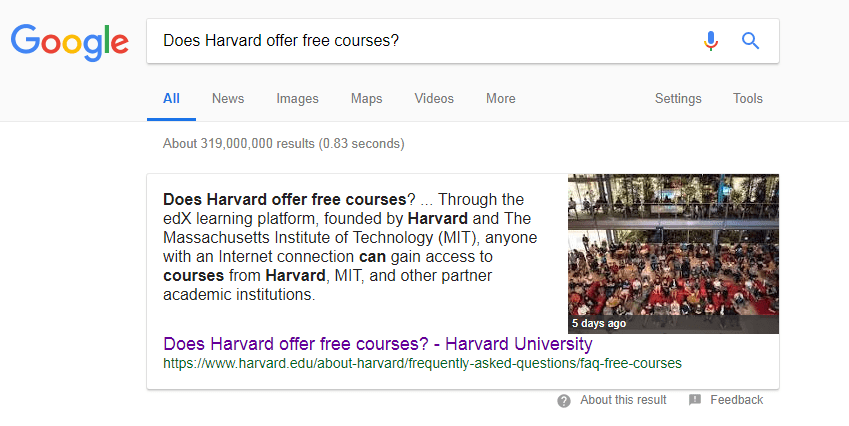
A good way to improve your chances is tailoring your questions for real speech. Because many of these searches will be carried out by voice, the language used is likely to be more informal than a regular search. Writing your FAQs content in a conversational style will increase its chances of showing in important searches.
Example: The University of Birmingham’s FAQs page makes good use of conversational language. This style closely mirrors real speech, increasing its chances of ranking in voice searches.

Do Your FAQs Direct Prospective Students to Other Pages on Your Site?
While an FAQs page should ideally provide fairly comprehensive answers to prospective students’ most pertinent questions, that doesn’t mean that it should be the final stop they make on your website. There are many ways schools can optimize their FAQs section to encourage further browsing, and even to nurture prospective students to take the next step in their enrollment journey.
Firstly, answers to pressing queries are often the perfect opportunity to point web users naturally in the direction of other pages. Each of your FAQs should be seen as a chance to deliver more relevant information to students, and provide them with links to other parts of your website that can provide more depth and value to your answer.
Example: Trillium College optimizes its FAQs page by providing links in the text to other relevant pages on its website.

Another good idea is to finish any FAQs page you create with a CTA that prompts prospective students to contact your school if they need more information. This gently nurtures them towards conversion, while also providing prospects who don’t feel like their question has been answered to their satisfaction with the chance to seek further assistance from your admissions team.
Should Your School’s Answers be Featured Elsewhere on Your Site?
While an FAQs section is an important and valuable part of your website, it should almost never be the only place where prospective students can find the information they are looking for. As a general rule of thumb, if enough of your audience are asking a particular question that it warrants inclusion in your FAQs, it should also be highlighted elsewhere.
FAQs are also not to be seen as a place to bury information that you are less keen to communicate with prospective students. For instance, some institutions will make the FAQs section the only place that they provide information about their course fees, particularly if they are high or potentially prohibitive. This is ultimately counterproductive, and can hinder your attempts to build trust with prospective students.
A good approach is to use your FAQs to present information as concise, simple answers to straightforward questions, and the rest of your website to address those areas in more depth. This will ensure that prospective students have every chance to get the information they need.
Are You Updating FAQs in Line With Higher Education Website Best Practices?
Last but not least, it is crucial to stress that FAQs be reviewed and updated regularly. Because FAQs have been part of the standard framework of a website for such a long time, it is common for them to become somewhat neglected as years go by.
This can lead to the information in the section becoming dated, or failing to reflect the needs and common goals of your current student base. Reviewing and updating the section regularly will help to ensure that you can add questions about new courses, facilities, or services, remove those that are no longer relevant, and ensure its design, content, and SEO elements are line with current higher education website best practices. And with FAQs becoming increasingly important in the current online climate, if you can’t remember the last time you reviewed yours, now is the time to do it.







